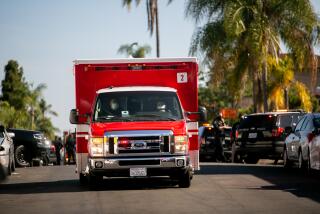911 is best call to make if heart attack strikes
If you live in Los Angeles, Ventura, Orange or San Diego county and think you are having a heart attack, call 911 rather than have a friend or family member drive you to the hospital. It could mean the difference between life and death.
That’s the conclusion of a UCLA professor who reviewed data from counties around the nation -- including four in Southern California -- that have implemented a new approach to handling heart attack patients.
By outfitting ambulances with devices that allow paramedics to more quickly diagnose serious heart attacks and call ahead to hospitals equipped to perform a specialized procedure, the protocol has sharply reduced the time it takes for patients to receive life-saving treatment, officials said.
Currently, only about half of all heart attack victims arrive at hospitals by ambulance.
When patients walk into emergency rooms on their own, long waits can delay diagnosis and treatment, health officials say. In October, Christopher Jones, 33, collapsed and died after waiting more than three hours at Olive View-UCLA Medical Center in Sylmar complaining of severe chest pain. Jones never received an electrocardiogram.
“Had that patient called 911, he would have been identified by the paramedics” as having a heart attack, said Dr. Ivan C. Rokos, the emergency medicine physician and assistant clinical professor at the David Geffen School of Medicine at UCLA who reviewed data on the new approach.
“Fortunately for 911 [callers], paramedics take care of one patient at a time,” Rokos said. “If you go into an emergency room, the triage nurse is overloaded.”
Even 15 minutes of delay in treating a heart attack increases the risk of death, he noted, and causes more damage to the heart.
Ninety percent of heart attack patients who called 911 in Los Angeles County had necessary procedures performed within 90 minutes of arriving at the hospital -- the highest rate of the counties studied -- according to data Rokos will present Sunday to the American College of Cardiology in Chicago.
Before the county instituted the protocol in December 2006, fewer than 50% were treated within 90 minutes.
Other Southern California counties recorded similar improvements, with Orange and Ventura counties reporting that 85% of patients now receive treatment within 90 minutes and San Diego reporting a rate of 86%.
Other regions that have adopted the protocol -- including Marin County, Atlanta, Minneapolis, Medford, Ore., and Oakland County, Mich. -- also have met the American College of Cardiology’s recommendation of treating at least 75% of severe heart attack victims within 90 minutes, a key time frame in preventing irreversible damage.
One central element of the protocol has been to equip ambulances with upgraded electrocardiogram machines that analyze the patient’s condition and alert paramedics when patients are having serious heart attacks.
The new approach was developed in response to growing evidence in the late 1990s that prompt care utilizing an improved procedure could save lives.
The emergency angioplasty procedure involves inserting a tube into the patient’s groin and threading it to the arteries near the heart.
Once doctors determine where an artery is blocked, a small balloon on the tube’s tip is inflated to force the fatty clot out of the way and restore blood flow to the heart. A metal stent can then be put in place to keep the artery open.
The emergency treatment, known as PPCI, for primary percutaneous coronary intervention, has the best chance of success if it is performed within 90 minutes of a patient’s arrival at a hospital. Since many hospitals are not staffed to perform the procedure, paramedics need to know whether patients are candidates for it.
Before Orange County implemented the protocol, patients often waited two hours or more for treatment, said Dr. Samuel Stratton, medical director of Orange County’s Emergency Medical Services.
Now, all ambulances have been equipped with upgraded electrocardiogram machines and patients in need of the procedure are taken only to hospitals staffed to perform it 24 hours a day.
Results are promising. Stratton said he is convinced that mortality rates have dropped in Orange County since the protocol was implemented in 2005, but didn’t have comparative statistics. Also, many patients in Orange County are now sent home within three to five days, rather than seven to 10 days, Stratton said.
The largest hurdle counties now face, Rokos said, is educating the public to call 911 when a heart attack is suspected.
“The paramedics can provide you with one-on-one concierge service,” Rokos said. “If you go into the emergency department, you’re fighting off the masses.”
--
--
(BEGIN TEXT OF INFOBOX)
Heart attack alert
Common symptoms:
Chest discomfort or pain that lasts more than a few minutes or returns
Discomfort in an arm, the back, neck, jaw or stomach
Shortness of breath
Nausea, vomiting, lightheadedness, fainting or breaking out in a cold sweat
What you should do:
Call 911 within five minutes of the start of symptoms.
Even if symptoms stop in less than five minutes, call a doctor.
For more information about heart attacks:
www.nhlbi.nih.gov/health/dci/
Diseases/HeartAttack/
heartattack_risk.html
For details about emergency angioplasty:
americanheart.org/presenter.
jhtml?identifier=4454
Source: National Heart Lung and Blood Institute
----
Treatment centers
These hospitals have been approved to participate in a new, faster approach to treating severe heart attacks in three Southern California counties.
In Los Angeles County
Antelope Valley Hospital
Beverly Hospital
Brotman Medical Center
Cedars-Sinai Medical Center
Centinela Freeman Regional Medical Center - Centinela Campus
Citrus Valley Medical Center - IC Campus
Encino-Tarzana Regional Medical Center - Tarzana Campus
Garfield Medical Center
Glendale Adventist Medical Center
Glendale Memorial Hospital and Health Center
Good Samaritan Hospital
Huntington Memorial Hospital
LAC Harbor-UCLA Medical Center
LAC USC Medical Center
Lancaster Community Hospital
Little Company of Mary Hospital
Long Beach Memorial Medical Center
Methodist Hospital of Southern California
Northridge Hospital Medical Center
Pomona Valley Hospital Medical Center
Presbyterian Intercommunity Hospital
Providence Holy Cross Medical Center
Providence Saint Joseph Medical Center
Saint John’s Health Center
Saint Mary Medical Center
Santa Monica-UCLA Medical Center
Torrance Memorial Medical Center
UCLA Medical Center
Valley Presbyterian Hospital
West Hills Hospital and Medical Center
White Memorial Medical Center
In Orange County
Anaheim Memorial Medical Center
Fountain Valley Regional Medical Center
Hoag Memorial Hospital Presbyterian
Irvine Regional Medical Center
Los Alamitos Medical Center
Mission Hospital
Saddleback Memorial Medical Center
St. Joseph Hospital
St. Jude Medical Center
UC Irvine Medical Center
West Anaheim Medical Center
Western Medical Center - Anaheim
Western Medical Center - Santa Ana
In Ventura County
Community Memorial Hospital
Los Robles Health and Medical Center
St. John’s Regional Medical Center
Sources: Los Angeles County Emergency Medical Services Agency, County of Orange Health Care Agency
More to Read
Sign up for Essential California
The most important California stories and recommendations in your inbox every morning.
You may occasionally receive promotional content from the Los Angeles Times.










